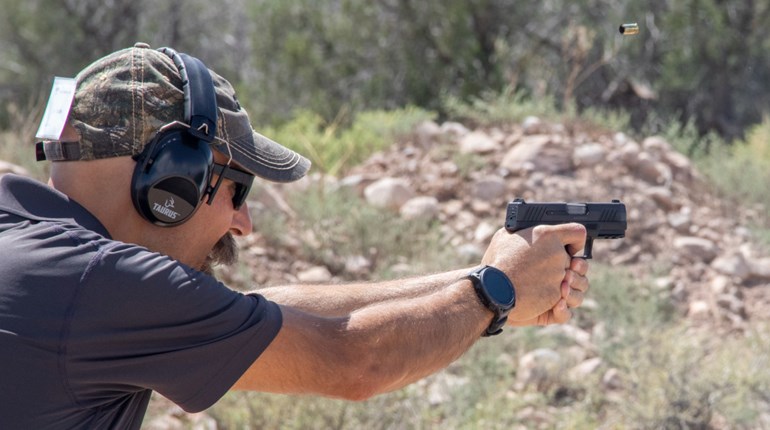
The process for shooting very well comprises three essential components – bring stability to alignment and break the shot without disturbing that alignment enough to cause a miss. The cornerstone to that tripart shooting process is stability.
Stability can take many forms. Starting from the ground up, stability begins with the most irrefutably stable firing position available which is the prone position with either a rifle or pistol.
The prone position consists of multiple body positions making as many effective points of contact with the ground as physically possible. Multiple options such as the quintessential military prone, Olympic prone, rollover prone, Special Boat Unit (SBU) prone and others provide traditional examples.
The prone position lends itself to an additional form of stability intrinsic to support of the rifle, carbine or pistol, which is equipment-based by way of tripod, bipod or unipod such as placing the magazine against the ground or a shooting stick or branch using it to create as stable a firing platform as possible. The combination of prone position to include multiple points of body-to-ground contact plus additional firearm-to-ground contact points afford the most stable firing platform available to the shooter.
The next level of stability up from the ground, is a seated position. There are multiple seated positions in shooting such as the cross-legged (or cross-seated) position, open-legged (or open-seated) position, chair (seated) position, seated bench rest and others.
Moving vertically from seated position are kneeling positions which although not as stable as prone or seated still allows the shooter multiple forms of body-to-ground contact points. Examples of this are the classical braced kneeling, speed kneeling and double kneeling positions and their variants.
Yet another viable option of what most shooters consider to be a seated position, is the squatting position. Commonly referred to as the “rice paddy” or “squatting seated” this position is often utilized as a traditional shooting stance in environments where sitting on the ground is impractical due to flooding, uneven micro-terrain or muddy conditions.
In this stability option, the shooter squats down, balancing on the balls of their feet (or completely flat on your feet if you’re flexible enough), with their knees bent and thighs mostly parallel to the ground. The feet are placed about shoulder-width apart for stability.
The shooter leans slightly forward, resting their elbows on their knees (or against the inside of their thighs) for additional support. Unlike most seated positions squatting provides a relatively stable firing platform by creating points of contact between the body and the ground allowing for quick transition to other positions or movements.
Suitable for various terrains, especially wet or uneven surfaces where other seated positions might be uncomfortable or impractical, squatting keeps the shooter low to the ground, reducing their profile and making them less visible. This position is particularly useful for shooters who need to stay low while maintaining a quick response capability, such as in tactical or hunting scenarios.
The next stability option vertical from squatting is the standing position. As with other positions, the rifle or carbine offers greater stability due to the multiple points of shooter-to-firearm contact than the pistol. Therefore, in the standing position a pistol offers the least amount of stability and therefore requires a greater amount of stabilization effort on behalf of the shooter.
Given a pistol, and in the standing position, you are relegated to only two control points – grip and structural.
Grip can be identified as starting at the forearms through the wrists and then the hands. Essentially all three of these are “welded” together to form as stable a platform as possible using physical strength to include consistent grip pressure. Structure begins at the torso and extends downward through the hips and legs and eventually to the bipedal support of the shooter connected with their feet to the ground.
The connectors of the grip to structural support include both the elbows and shoulders affording a level of hold control commensurate with the stability needed to make one or multiple shots.
The least of all the stability options occurs in dynamic movement such as shooting on the move where your structural support is in constant flux like running. At times you may need to rely on nothing more than your own balance to adequately stabilize the firearm in such continual rapid and dynamic movement.
Mastering the gamut of shooting stability options significantly impacts shot placement efficiency and control. Starting from the most stable prone position, with its exceptional ground contact and support options, shooters can progress through kneeling, seated, squatting and standing positions, each offering varying degrees of stability suited to different environments and situations.
Developing the skills required for each stability option, from the low-profile prone to shooting on the move, equips shooters with the versatility needed for practical scenarios. Familiarity with multiple stability options, whether in stationary or dynamic shooting, sets the foundation for on-demand consistent marksmanship.



































